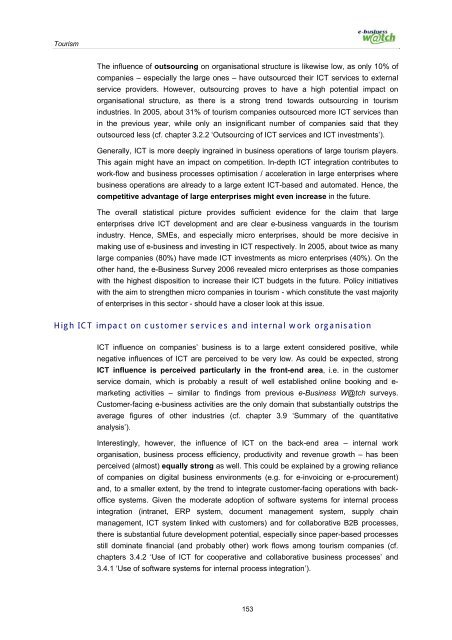ICT and e-business in the tourism industry ICT adoption ... - empirica
ICT and e-business in the tourism industry ICT adoption ... - empirica
ICT and e-business in the tourism industry ICT adoption ... - empirica
Create successful ePaper yourself
Turn your PDF publications into a flip-book with our unique Google optimized e-Paper software.
Tourism<br />
The <strong>in</strong>fluence of outsourc<strong>in</strong>g on organisational structure is likewise low, as only 10% of<br />
companies – especially <strong>the</strong> large ones – have outsourced <strong>the</strong>ir <strong>ICT</strong> services to external<br />
service providers. However, outsourc<strong>in</strong>g proves to have a high potential impact on<br />
organisational structure, as <strong>the</strong>re is a strong trend towards outsourc<strong>in</strong>g <strong>in</strong> <strong>tourism</strong><br />
<strong>in</strong>dustries. In 2005, about 31% of <strong>tourism</strong> companies outsourced more <strong>ICT</strong> services than<br />
<strong>in</strong> <strong>the</strong> previous year, while only an <strong>in</strong>significant number of companies said that <strong>the</strong>y<br />
outsourced less (cf. chapter 3.2.2 ‘Outsourc<strong>in</strong>g of <strong>ICT</strong> services <strong>and</strong> <strong>ICT</strong> <strong>in</strong>vestments’).<br />
Generally, <strong>ICT</strong> is more deeply <strong>in</strong>gra<strong>in</strong>ed <strong>in</strong> <strong>bus<strong>in</strong>ess</strong> operations of large <strong>tourism</strong> players.<br />
This aga<strong>in</strong> might have an impact on competition. In-depth <strong>ICT</strong> <strong>in</strong>tegration contributes to<br />
work-flow <strong>and</strong> <strong>bus<strong>in</strong>ess</strong> processes optimisation / acceleration <strong>in</strong> large enterprises where<br />
<strong>bus<strong>in</strong>ess</strong> operations are already to a large extent <strong>ICT</strong>-based <strong>and</strong> automated. Hence, <strong>the</strong><br />
competitive advantage of large enterprises might even <strong>in</strong>crease <strong>in</strong> <strong>the</strong> future.<br />
The overall statistical picture provides sufficient evidence for <strong>the</strong> claim that large<br />
enterprises drive <strong>ICT</strong> development <strong>and</strong> are clear e-<strong>bus<strong>in</strong>ess</strong> vanguards <strong>in</strong> <strong>the</strong> <strong>tourism</strong><br />
<strong>in</strong>dustry. Hence, SMEs, <strong>and</strong> especially micro enterprises, should be more decisive <strong>in</strong><br />
mak<strong>in</strong>g use of e-<strong>bus<strong>in</strong>ess</strong> <strong>and</strong> <strong>in</strong>vest<strong>in</strong>g <strong>in</strong> <strong>ICT</strong> respectively. In 2005, about twice as many<br />
large companies (80%) have made <strong>ICT</strong> <strong>in</strong>vestments as micro enterprises (40%). On <strong>the</strong><br />
o<strong>the</strong>r h<strong>and</strong>, <strong>the</strong> e-Bus<strong>in</strong>ess Survey 2006 revealed micro enterprises as those companies<br />
with <strong>the</strong> highest disposition to <strong>in</strong>crease <strong>the</strong>ir <strong>ICT</strong> budgets <strong>in</strong> <strong>the</strong> future. Policy <strong>in</strong>itiatives<br />
with <strong>the</strong> aim to streng<strong>the</strong>n micro companies <strong>in</strong> <strong>tourism</strong> - which constitute <strong>the</strong> vast majority<br />
of enterprises <strong>in</strong> this sector - should have a closer look at this issue.<br />
High <strong>ICT</strong> impact on customer services <strong>and</strong> <strong>in</strong>ternal work organisation<br />
<strong>ICT</strong> <strong>in</strong>fluence on companies’ <strong>bus<strong>in</strong>ess</strong> is to a large extent considered positive, while<br />
negative <strong>in</strong>fluences of <strong>ICT</strong> are perceived to be very low. As could be expected, strong<br />
<strong>ICT</strong> <strong>in</strong>fluence is perceived particularly <strong>in</strong> <strong>the</strong> front-end area, i.e. <strong>in</strong> <strong>the</strong> customer<br />
service doma<strong>in</strong>, which is probably a result of well established onl<strong>in</strong>e book<strong>in</strong>g <strong>and</strong> e-<br />
market<strong>in</strong>g activities – similar to f<strong>in</strong>d<strong>in</strong>gs from previous e-Bus<strong>in</strong>ess W@tch surveys.<br />
Customer-fac<strong>in</strong>g e-<strong>bus<strong>in</strong>ess</strong> activities are <strong>the</strong> only doma<strong>in</strong> that substantially outstrips <strong>the</strong><br />
average figures of o<strong>the</strong>r <strong>in</strong>dustries (cf. chapter 3.9 ‘Summary of <strong>the</strong> quantitative<br />
analysis’).<br />
Interest<strong>in</strong>gly, however, <strong>the</strong> <strong>in</strong>fluence of <strong>ICT</strong> on <strong>the</strong> back-end area – <strong>in</strong>ternal work<br />
organisation, <strong>bus<strong>in</strong>ess</strong> process efficiency, productivity <strong>and</strong> revenue growth – has been<br />
perceived (almost) equally strong as well. This could be expla<strong>in</strong>ed by a grow<strong>in</strong>g reliance<br />
of companies on digital <strong>bus<strong>in</strong>ess</strong> environments (e.g. for e-<strong>in</strong>voic<strong>in</strong>g or e-procurement)<br />
<strong>and</strong>, to a smaller extent, by <strong>the</strong> trend to <strong>in</strong>tegrate customer-fac<strong>in</strong>g operations with backoffice<br />
systems. Given <strong>the</strong> moderate <strong>adoption</strong> of software systems for <strong>in</strong>ternal process<br />
<strong>in</strong>tegration (<strong>in</strong>tranet, ERP system, document management system, supply cha<strong>in</strong><br />
management, <strong>ICT</strong> system l<strong>in</strong>ked with customers) <strong>and</strong> for collaborative B2B processes,<br />
<strong>the</strong>re is substantial future development potential, especially s<strong>in</strong>ce paper-based processes<br />
still dom<strong>in</strong>ate f<strong>in</strong>ancial (<strong>and</strong> probably o<strong>the</strong>r) work flows among <strong>tourism</strong> companies (cf.<br />
chapters 3.4.2 ‘Use of <strong>ICT</strong> for cooperative <strong>and</strong> collaborative <strong>bus<strong>in</strong>ess</strong> processes’ <strong>and</strong><br />
3.4.1 ‘Use of software systems for <strong>in</strong>ternal process <strong>in</strong>tegration’).<br />
153

















